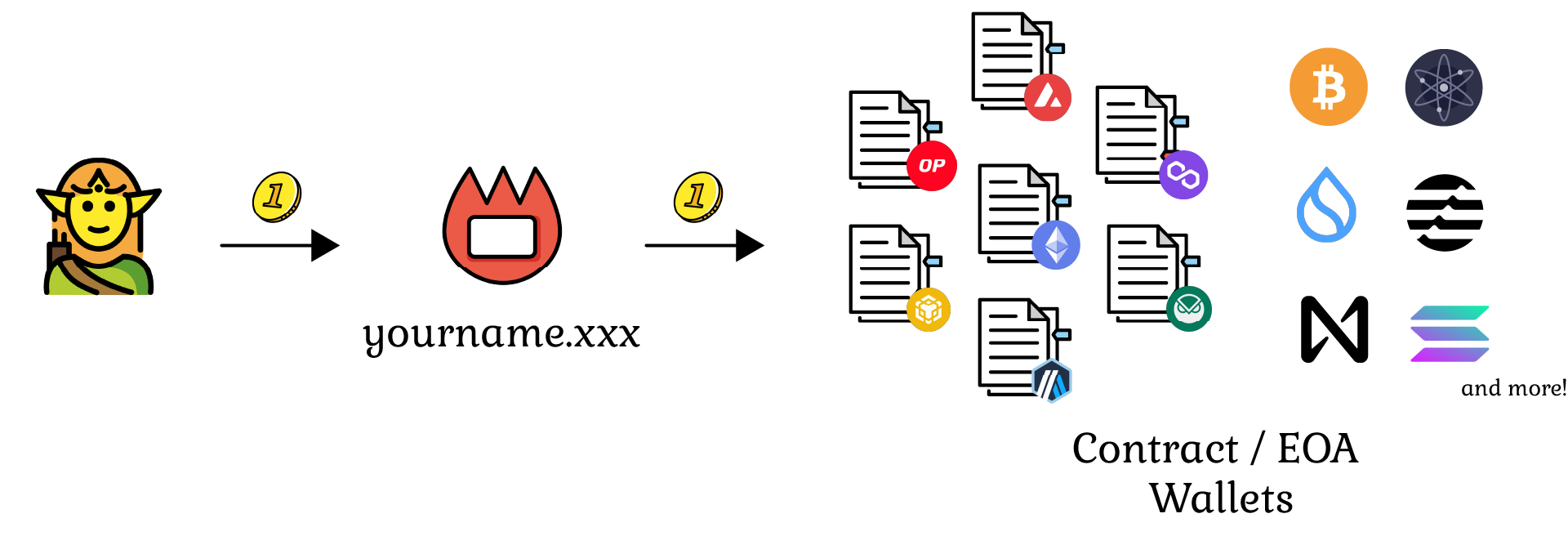Mycel ID
Mycel ID is at the heart of the Mycel infrastructure, serving as a unique digital identifier in the multi-chain world, structured in a domain-like format with Top-Level Domains (TLD) and Second-Level Domains (SLD).
Managed on-chain within Mycel's Tendermint-based blockchain, Mycel ID ensures secure, decentralized control over these digital identities. This on-chain management system underscores the platform's commitment to security and decentralization, leveraging the robustness of Tendermint's consensus mechanism. The domain-like format of Mycel ID not only enhances the intuitiveness and memorability of the identities but also mirrors the familiar structure of internet domains, facilitating an easy transition for users.
By merging the convenience of Web2 identity systems with the inherent security and decentralization of Web3, and supporting a variety of authentication methods, Mycel ID offers a seamless bridge to the Web3 space, ensuring users can manage their identities effortlessly and securely across the blockchain landscape.
Customizable IDs
 Mycel ID is serving as a unique digital identifier in the multi-chain world, structured in a domain-like format with Top-Level Domains (TLD) and Second-Level Domains (SLD).
This system is attractive to organizations with communities seeking more flexible and customizable naming services.
Mycel ID is serving as a unique digital identifier in the multi-chain world, structured in a domain-like format with Top-Level Domains (TLD) and Second-Level Domains (SLD).
This system is attractive to organizations with communities seeking more flexible and customizable naming services.
Interoperability
 Mycel supports communicate with other blockchain network like:
Mycel supports communicate with other blockchain network like:
- Ethereum and other EVM compatible chains
- IBC Supported chains
It possible to register and resolve domains, and update records from various blockchain network.
And this enables seamless integration with various name services:
- Ethereum Name Service (ENS)
- Inter-Chain Name Service (ICNS)
...
This integration can increase utility for users who have existing domains on those services or want to access features provided by them
Also, Mycel supports almost of all chain's wallet addresses. It is possible to resolve multiple addresses for each chain, such as contract wallets, with a single name.
Multiple Protocols Support
Mycel caters to different user needs by supporting various protocols and a range of record types. Supported record types:
- Domain Name System (DNS) records
- Wallet addresses
- IPFS addresses
- Metadata records, which can store any custom data
And, you can resolve domains via the following protocols:
- Domain Name Service (DNS)
- Inter‑Blockchain Communication Protocol (IBC)
- Name Service Contract(EVM)
- RPC
You will be able to manage complex addresses with one domain. This means that it is possible to track multiple chains of activity under one domain.
Domain Registration
Domain registration is a crucial aspect of the Mycel project. It provides users with the ability to secure unique domain names that can be used to represent their websites, services, or digital assets on the decentralized web. The Mycel domain registration process consists of two levels: Top-Level Domains (TLDs) and Second-Level Domains (SLDs). Here, we will delve into the details of each level and the registration process.
You can register domain from here
Domains
Top-Level Domains (TLDs)
TLDs are the highest level in the domain name hierarchy, such as .com, .org, or .net. In Mycel, validators are responsible for registering TLDs. The process of issuing a TLD within the Mycel system involves several key steps:
- The TLD applicant must pay a registration fee in tokens (such as USDC) equivalent to the desired number of accounts per year multiplied by a specific rate.
- Locking of Registration Fee: The paid registration fee is then locked within the Mycel system.
- Mycel calculates the amount of MYCEL tokens to burn based on the locked registration fee and a specific rate. The tokens are then burnt, effectively removing them from circulation.
- Upon successful completion of the above steps, Mycel issues the TLD to the applicant.
Second-Level Domains (SLDs)
SLDs are the domain names that users typically register and use for their projects, such as example.com or myproject.org. In the context of Mycel, the primary SLD is .cel (e.g., myproject.cel). Users can register SLDs under the .cel TLD to represent their projects or assets in the decentralized ecosystem.
The registration fee for SLDs depends on the number of characters in the domain name. This variable pricing structure incentivizes users to select shorter domain names, which are generally more memorable and valuable.
Domain Registration Process
To register a domain in Mycel, users must follow these steps:
- Choose a unique SLD that is not already registered. The SLD should be concise, memorable, and representative of the user's project or asset.
- Calculate the registration fee based on the number of characters in the chosen SLD.
- Connect a supported wallet (e.g., Kepler or MetaMask) with sufficient funds to cover the registration fee.
- Submit a domain registration request through the Mycel platform. The request will be processed, and if successful, the domain will be registered to the user's wallet address.
- Optionally, users can create subdomains for their registered SLDs free of charge.
By providing a decentralized domain registration system with a user-friendly process, Mycel enables users to secure unique domain names for their projects and assets in the decentralized web.